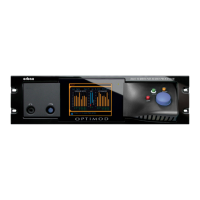OPTIMOD SURROUND PROCESSOR OPERATION
3-37
noise. Additionally, large amounts of boost will increase the gain reduction in the
lowest band of the multiband compressor, which may have the effect of reducing
some frequencies below 100 or 200 Hz (depending on the setting of the B1/B2
XOVER control). So be aware the large fixed bass boosts may have a different effect
than you expect because of the way that they interact with the multiband compres-
sor.
On the other hand, stations specializing in pop music programming will usually want
to employ some bass boost to maintain the punch of this programming, particularly
if urban or rap music is a significant part of the music mix.
Low Frequency Parametric Equalizer
is a specially designed equalizer whose
boost and cut curves closely emulate those of a classic Orban analog parametric
equalizer with conventional bell-shaped curves (within ±0.15 dB worst-case). This
provides warm, smooth, “analog-sounding” equalization.
LF Frequency
determines the center frequency of the equalization, in
Hertz. Range is 20-500Hz.
LF Gain
determines the amount of peak boost or cut (in dB) over a ±10
dB range.
LF Width determines the bandwidth of the equalization, in octaves. The
range is 0.8-4.0 octaves. If you are unfamiliar with using a parametric
equalizer, 1.5 octaves is a good starting point. These curves are relatively
broad because they are designed to provide overall tonal coloration, in-
stead of notching out small areas of the spectrum.
The LF parametric can be used in the mid-bass region (100-300Hz) to add “warmth”
and “mellowness” to the sound when boosting. When cutting, it can remove a
“woody” or “boxy” sound.
The equalizer, such as the classic Orban analog parametrics like the 622B, has con-
stant “Q” curves. This means that the cut curves are narrower than the boost curves.
The width (in octaves) is calibrated with reference to 10 dB boost. As you decrease
the amount of EQ gain (or start to cut), the width in octaves will decrease. However,
the “Q” will stay constant.
“Q” is a mathematical parameter that relates to how fast ringing damps out. (Tech-
nically, we are referring to the “Q” of the poles of the equalizer transfer function,
which does not change as you adjust the amount of boost or cut.)
The curves in the 8685’s equalizer were created by a so-called “minimax” (“minimize
the maximum error” or “equal-ripple”) IIR digital approximation to the curves pro-
vided by the Orban 622B analog parametric equalizer. Therefore, unlike less sophis-
ticated digital equalizers that use the “bilinear transformation” to generate EQ
curves, the shapes of the 8685’s curves are not distorted at high frequencies.
Midrange Parametric Equalizer
is a parametric equalizer whose boost and cut
curves closely emulate those of an analog parametric equalizer with conventional
bell-shaped curves.

